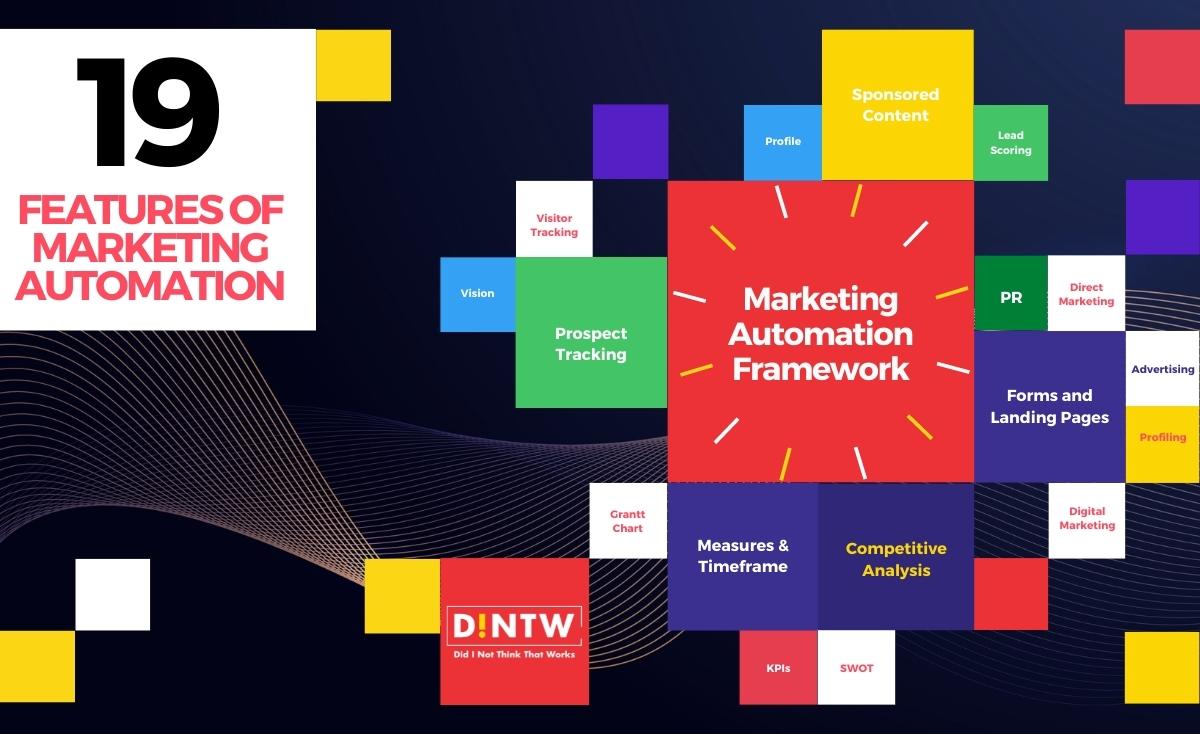Marketing Automation was inevitable, and it is just that the last 24 months have accelerated its implementation. With the new learnings, marketers will be more stringent in the marketing automation features they want to use. Because
"Going forward, real-time marketing will be the holy grail of marketing".
We don’t want to sound like we’re making a prophecy, so we wrote you a detailed article on the importance of enterprise-grade marketing automation tools. Please go ahead and go through the list first.
- Why use Marketing Automation?
- What is the role of marketing automation in the sales funnel?
- How do we measure the ROI of a marketing automation tool?
- The right time to onboard an automation software
- Which are the most used features of marketing automation across businesses?
- Visitor Tracking
- Create and Distribute Sponsored Content
- Keep track of content marketing inside automation software
- Observe the Prospect’s Activity
- Score And Grade Lead to creating an Ideal Profile.
- Make it easier to assign leads.
- Nurturing New Leads
- Design Forms & Landing Pages
- Continuing profiling – forms, lead scoring.
- The use of dynamic content
- Email marketing software
- Contact Profiling
- Smart Lists and Segmentation
- Local Integration
- Use the A/B Testing feature of automation software.
- Seamless Integration with your automation tool
- Integration & Reporting for CRM via automation platform
- Application of AI to Marketing Automation Software
- Organic Search and Paid Search Insights
- Social Media Management & Scheduling
- Next Steps:
Why use Marketing Automation?
Marketing professionals will be the first to inform you about interesting and brand-new patterns like marketing automation tools. Marketing automation (MA) is a core aspect of marketing operations from small companies to large enterprises. When utilised appropriately, it oversees streamlining substantial renovations in marketing campaigns and sales processes throughout online and offline channels.
Marketing automation technology drives your organization into a new age of relationship-based marketing with quantifiable outcomes. With the right combination of cutting-edge technology, efficient implementation and well-managed internal processes, your firm will be well on its way to achieving new levels of profitability.
If you already use an MA tool, follow these 15 steps to boost your marketing automation in 2023.
What is the role of marketing automation in the sales funnel?
There are several success stories on how marketing automation combined with email and social media marketing can reduce the cost of customer acquisition and increase the lead to cash optimization. For a small business, it is automation at scale.
- Marketing automation is presently used by 51% of firms.
- 40% of marketers feel automation boosts productivity.
- Marketing automation increased lead generation for 80% of businesses.
- Marketing automation isn’t used by 48.6% of organizations owing to inexperience.
- 77% of marketers employing marketing automation tools increased conversions.
- Marketing automation through email is the most common.
Even if you understand marketing automation is vital, you must pick the best platform. To do so, you must recognize the essential marketing automation attributes you need for an automation tool. We’ve compiled a list of the most used features across marketing automation tools to assist your selection process. Use them to ensure you understand all the needed parts and their requirements.
To give you this checklist, we’ve evaluated the best marketing automation software, such as HubSpot, Adobe Marketing Cloud, SendGrid, MailChimp, SendinBlue, EngageBay, Marketo, and Pardo. These features are applicable for both eCommerce and B2B marketing automation.
How do we measure the ROI of a marketing automation tool?
John Wanamaker, the owner of the first department store in the United States, said,
“I know half my advertisement is wasted; the trouble is I don’t know which half”.
Campaign-oriented marketing and advertising are attributed to the short-term cost of enhancing the company’s performance. In fact, according to a new study, John Wannamaker’s “waste” may be the most valuable resource.
We need to understand why some loss-leading efforts benefit the organization and how to deal with the potential delay in a campaign’s outcomes.
- There is an attribution problem in which the results of many initiatives are attributed to each other.
- Furthermore, it is essential to remember the long-term implications of brand creation, which are often overlooked.
In the last 18 months, the sales and marketing alignment has been the most significant success of marketing automation. Today’s marketing team wants the following answers from a marketing automation platform:
- Who are my best customers? How can I obtain more? You must use the benefits of market segmentation↗ for your brand.
- Where do users leave the funnel? Lead Management
- Is the sales staff spending too much time on repetitive tasks?
- Even though my pipeline is complete, no conversions are taking place. Why?
- Are we producing enough sales leads?
- Do leads occasionally slip through the gaps from marketing to sales?
- Do we have a particular way of assessing our success?
- Are we making the most out of good customer experience and customer data?
But as a CEO or company owner, you may leverage marketing automation and inbound marketing to have the following answers from your sales team:
- How much quicker are sales today than last quarter? 2017?
- How much more profit do we make this quarter than last?
- What do you expect for next quarter’s sales and profit?
- ROI on Digital Marketing Spend
The right time to onboard an automation software
For the most part, companies need a comprehensive platform for all marketing efforts. As a result, they have already identified several effective marketing channels.
Which means,
- You’ve had success in more than a few different places.
- You’ve already made financial commitments to expanding your marketing efforts.
- Scale up the functioning channels or try new ones to see what works best.
These marketing automation tools are perfect for your company and a small business making its first move. All-in-one automation technologies may help you grow and automate all parts of your marketing operation, from email automation to ad purchasing to lead nurturing.
But there is no need to go all-in in the beginning. If you’re looking for email marketing automation, don’t get an all-in-one solution because you don’t need it for everything. Review your needs and use cases, and then identify how a marketing automation platform may serve those goals.
Lead scoring is one of the most critical components of marketing activity, but there are many more. Lead scoring is vital to all automation campaigns, whether you’re using it for social media monitoring or email marketing. Among the other features are CRM connectivity and email campaign capability.
Which are the most used features of marketing automation across businesses?
Use marketing automation software with vital capabilities for your company. For example, it’s impossible to create and manage many users in Mailchimp. Budget-conscious companies and online store owners should consider it, though. Mailchimp’s e-commerce connectors and transactional email capabilities make it a good choice for online retailers, even though it lacks more complex features.
We have implemented, integrated, and operationalized over 50 functionalities across ten automation systems. The top 20 qualities of every marketing product are responsible for 80% of the marketing goals achieved.
To avoid the “shiny object syndrome,” marketing directors should focus on the customer journey and experience.
Listed here are the 19 most-used marketing automation features:
Use the below features checklist to evaluate marketing automation requirements for your company.
Visitor Tracking
One of the features of your marketing automation will be visitor monitoring. Visitor tracking software lets you know who visits your website and how long they stay on each page. It also tells you which articles are getting the most attention and responses. Visitor Tracking lets you learn more about who is reading your content and what they find most appealing. That’s a lot of information to have!
Create and Distribute Sponsored Content
You may host (upload and publish) your marketing automation content on your website. Typically, a website and a marketing tool are combined. It might be a downloadable asset connected to a form (i.e., the user completes the form, submits it, and receives the free download), a landing page, or email content.
Keep track of content marketing inside automation software
How to prove the value of your content? Indicate the importance of content initiatives by linking them to marketing analytics. Your marketing automation solution can track the traffic and performance of your content. Content marketing analytics is a terrific way to find out what works. All good marketing automation software has this feature in-built.
Observe the Prospect’s Activity
Tracking a prospect’s progression through a funnel is time-consuming for sales and marketing teams. Thankfully, marketing software enables you to configure your tool to notify you when a lead does ready-to-convert actions. This allows you to intervene appropriately and focus on crucial tasks until then.
Score And Grade Lead to creating an Ideal Profile.
Outbound or inbound marketing initiatives might help you identify which leads are more likely to buy than others. Using lead scores and grading can be beneficial in this situation. This feature allows marketing automation platforms to provide a score to a lead based on their behaviours or specific demographic and firmographic criteria. As a result, the higher a lead’s score, the more probable the person will make a purchase.
Make it easier to assign leads.
The automated assignment of leads is an additional feature that complements lead scoring. You’ll have to set your threshold to determine when the lead is ready to buy. A salesperson can be automatically assigned to a prospect if it reaches the minimal score. You have complete control over managing your potential customers and sending them to your sales representatives. Whatever works best for your company can be done alphabetically, geographically, or in a round-robin fashion.
Nurturing New Leads
Lead nurturing is an essential part of any marketing task. It saves your sales rep time on non-buying prospects. As a result, lead nurturing is for the less experienced, younger opportunities who need to be educated (marketed to). It’s called “drip marketing” because you continuously deliver little content to maintain a brand recall. So that, when they’re ready to buy, they’ll think of you first. Lead nurturing may also aid with client retention, loyalty, and upselling.
Design Forms & Landing Pages
Landing pages and forms are vital in marketing initiatives. A decent marketing tool will let you create and configure professional landing pages and contact forms without coding skills. Create, host, and ab-test landing pages and forms with drag-and-drop ease and track their real-time performance during marketing campaigns. You may also create triggers to send an email, inform you, or improve a lead score based on a lead’s engagement with this material.
Continuing profiling – forms, lead scoring.
Forms are a great way to capture leads. Lengthy forms harm lead generation efforts. However, marketing automation software developers have come up with a solution! Progression profiling is the technical term for what we’re doing. Incremental profiling lets you reduce the number of form fields to only essential ones. Once the step-1 form is complete, it creates a potential lead in the system. Subsequently, they will be shown more fields on any future forms they fill out for downloading content, registration and other related marketing activities. Over time, this allows you to gather enormous insight into a potential customer.
The use of dynamic content
If you’re looking into marketing tools, you already know that today’s consumers don’t want just to be sold to; they want to be involved. With dynamic content, you can segment the subject matter and prospect together. This feature has significantly affected how many people visit and interact with a site. Best of all, it can take more than one shape. Landing pages, emails, forms, and templates can all use dynamic content.
Email marketing software
Email marketing and autoresponders are the first things that spring to mind for most beginners when considering an all-in-one marketing automation solution. While marketing automation encompasses much more, email marketing is a significant component. With marketing automation, you can segment the content you send to specific contacts, use A/B testing to enhance engagement and open rates, and send automatic follow-up messages in response to a prospect’s activity.
Contact Profiling
Contact profiling or Contact Management is a simple yet precious function of marketing automation software. Profiling allows you to save and retrieve contact information effortlessly. It can also log all your company’s interactions with the contact so you can understand where they are in the sales cycle at any time. Furthermore, most salespeople rely on contact management to save notes and other enrichment materials to supplement their sales talks with prospects.
Smart Lists and Segmentation
Smart lists allow you to segment your database based on criteria or measures. If you have content that only appeals to a subset of your database, a smart list is the best way to reach them. Remarketing, also called retargeting, primarily uses these potential leads to increase conversion rates.
Local Integration
If a program or software was built for operation on a specific platform, it is known as “local integration.” In some instances, the same business creates the application and platform. A firm’s purchase might attempt to make the application work with the platform effortlessly, as Salesforce Pardot has done. Primarily, local or native integration (like CRM integration) results in better performance and easier maintenance. As a result, it’s a sought-after feature of automation software.
Use the A/B Testing feature of automation software.
As discussed, ab testing is a method for making minute adjustments to content to determine which version is superior in lead engagement. The customer data will provide new ideas to appeal to your lead database. They can optimize your campaign via A/B testing if you utilise marketing automation software. With this newfound information, you can produce content, tweak your marketing process to be more pertinent to your audience and enhance your metrics.
Seamless Integration with your automation tool
Marketing automation software should be able to interface with sophisticated enterprise-level technologies. The following are some common instances of integrations:
- Connectors for Webinars and Videos, respectively
- Social Media
- Paid ad
- URL shorteners
- Tools for Customer Success
- Messaging Tools (Chatbot, SMS, Text)
- eCommerce
- Optimization or SEO Tools
- Creative and Design application
- 3rd party Analytics
Combining these products is extremely important to many firms heavily reliant on marketing automation.
Integration & Reporting for CRM via automation platform
Reporting on customer data is an essential aspect of marketing automation software. Real-time reporting enables you to link closed transactions to the generated campaigns, analyze campaign expenditures, and synchronize client data with your sales staff’s customer relationship management solutions (CRM). Thus, you will have the clarity and knowledge to evaluate your ROI and attribution. CRM will help you establish the source of your top leads and allow you to prioritize your budget and channels.
Application of AI to Marketing Automation Software
Artificial Intelligence (AI) can enhance your marketing automation initiatives. It may personalize email marketing, nurture campaigns and cross-selling possibilities, and increase client retention. AI algorithms can rapidly identify all possible campaigns for each consumer. AI and ML enable marketers to design more campaigns and experiences at scale.
Organic Search and Paid Search Insights
Organic search is unpaid, natural rankings. It demonstrates that people demand your product via landing pages/websites. Paid search enables you to deliver to have your ad campaign’s keywords or phrases visible on a search engine or social media site. Marketing Automation software frees you from dull and repetitive chores like scheduling and publishing, allowing you to concentrate on developing and executing new marketing strategies. A marketing automation platform’s SEO and paid marketing functions consist of:
Search Engine Optimization:
- Discovering search phrases
- SEO-optimized content
- Using search engine keywords
- Content tailored to demographics and localities
- Building a website reputation that the audience trusts
Paid Marketing Automation:
- First-visitor tracking (referral source).
- Conversion-tracking (the first form they fill out or engage with your chatbot).
- Orchestrating how marketing and sales engage the buyer.
- Tracking the prospect’s purchase.
Another primary usage is reporting. Marketers may develop reports to see which marketing is effective. They may also monitor which advertising or organic links attract site traffic.
Social Media Management & Scheduling
Social media management and marketing automation may automate and scale promotional efforts, giving more time for online interaction. Use these technologies correctly, focus on outcomes, and tweak automation to retain a human-like experience. Many companies lack a dedicated social media staff. Marketing automation systems let you submit content calendars and plan articles. You can plan off-hours postings. These systems evaluate real-time data, report critical metrics, deliver personalized reports, and suggest client responses. They can even auto-reply to client questions. The functionalities include the following:
- Choose which platforms to automate and how much.
- Automate: Analytics reports, chatbot scheduling
- Determine the most engaging content forms.
- Content and calendar creation
- Content scheduling
Here is a comprehensive list of social media automation tools to help your business.
Next Steps:
Because of current platforms’ extensive integration capabilities, the two types of technology are designed to work together in ways that were never previously possible. Aside from eliminating monotonous work, automation increases the company’s ROI and saves money on marketing.
Before you sign the cheque for your new marketing automation platform, you must understand what each system provides for you and what it does not.






